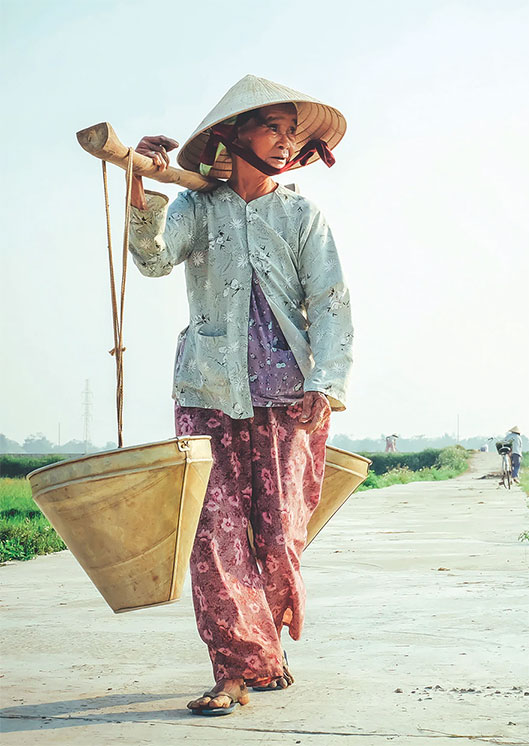Vietnam: the unknown force in world coffee

The second largest coffee producing country in the world has its own history and distinct coffee culture.
Southeast Asian coffee has returned to the forefront, as the recent lockdown in Vietnam to tackle coronavirus transmission has affected Robusta production and, consequently, global coffee stocks, with the possibility of a global outbreak crisis.
On this occasion, we remember the once "bad boy" of the coffee industry, the Vietnamese Robusta and take a look at the history and culture of the Asian country.
A Brief History of Coffee in Vietnam
 Coffee arrived in the country in 1857 by French missionaries, but the first plantations were not organized until almost 30 years later. Although Vietnam is now synonymous with Robusta production, the first coffee trees to be planted were of the Arabica variety. Gradually, under the rule of the French colonialists, coffee cultivation spread throughout the country, only to be disrupted during the Vietnam War. After the war, production was organized and systematized by trade unions, while the relative economic liberalization of the 1980s sent production soaring.
Coffee arrived in the country in 1857 by French missionaries, but the first plantations were not organized until almost 30 years later. Although Vietnam is now synonymous with Robusta production, the first coffee trees to be planted were of the Arabica variety. Gradually, under the rule of the French colonialists, coffee cultivation spread throughout the country, only to be disrupted during the Vietnam War. After the war, production was organized and systematized by trade unions, while the relative economic liberalization of the 1980s sent production soaring.
Vietnam's shift to Robusta production came in the late 1970s, when successive bad harvests in Brazil significantly reduced global coffee stocks, causing significant shortages, especially in the East. East Germany financed Vietnamese coffee production by offering, among other things, mechanical equipment to secure the coveted beans. The Asian country turned to intensive Robusta cultivation, as this variety bears fruit faster, is more resistant to pests and diseases and requires less hard work.
Today, Vietnam is the second largest coffee producer in the world, behind only the dominant Brazil, and the largest producer Robusta, with a long way from the next. Robusta accounts for 97% of Vietnam's national coffee production and is the country's most important exportable product, and the most widespread agricultural product after rice.
What is the taste of Vietnamese Coffee?
 For many years, Vietnamese coffee was not highly regarded by connoisseurs of the genre. Mass production of Robusta initially met the needs of eastern countries and then was channeled to a large percentage to instant coffee companies. Today, although production remains naturally massive, know-how has improved and the Vietnamese experience has led to significantly better quality coffee.
For many years, Vietnamese coffee was not highly regarded by connoisseurs of the genre. Mass production of Robusta initially met the needs of eastern countries and then was channeled to a large percentage to instant coffee companies. Today, although production remains naturally massive, know-how has improved and the Vietnamese experience has led to significantly better quality coffee.
Vietnamese robusta is earthy, with hints of wood and caramel, strong body and intensity. It is usually roasted intensely, and participates in espresso blends, offering strength and a thick cream. It is difficult to find as a single variety, although this is something that may change in the coming years. However, most of us have tried it, even if we do not know it, either as an instant coffee or in an espresso blend, especially if we prefer strong, Italian espresso blends.
For a traditional espresso blend with a dose of strong Vietnamese Robusta, we can choose Buondi Craft Rich, Lavazza Super Crema, or Gimoka Dulcis Vitae, which utilize the intensity and bitterness of this coffee in the best way.
Getting to know the Vietnamese Coffee Culture
Like all coffee-producing countries, Vietnam has developed its own, distinct coffee culture, which is naturally related to that of other Southeast Asian countries. The strong filter coffee is served with plenty of sugar and milk, while the Vietnamese prefer sugary milk, as among other things it offers the coffee a special, delicious texture. The Vietnamese coffee culture is a product of a lot of need and habit: bitter, strong coffee definitely had to be diluted and sweetened, while the only milk that was widely available was condensed sugar, as canned foods were much easier to keep fresh. milk.
What makes Vietnamese coffee unique is the special utensil in which it is extracted. The Vietnam Dripper Pot adapts to each glass and uniquely extracts the coffee in individual doses, while the milk or ice cubes have already been placed in the glass, if one wishes coffee in its iced version. A similar vessel exists in India, a country with a relatively similar coffee culture.
Vietnam is and will remain a viable "player" in the global coffee market - and as espresso lovers, all we can hope for is that production in Asia quickly return to pre-covid levels before the difficult situation develops into generalized crisis.










